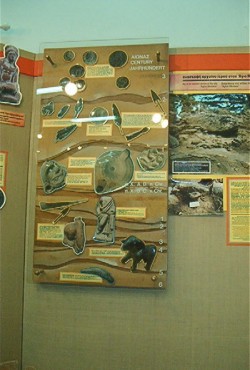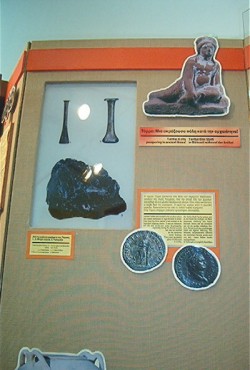Historical data of the region of White Mountains
Emmanouela Chiotaki – Maria Ksipolitaki – Maria Vagionaki
6th Grade students
 Samaria Gorge was created many centuries ago – about 14000000 – when the forces that motivated the earth's crust squeezed, folded and finally broke the outer rock layers of our planet. Later, water took action moving southeast towards the sea, eroding the rocks (mainly calcareous) thus creating the steep yet impressive scenery of the Gorge.
Man's presence in the broader area goes back many centuries. The isolation and wildness of the landscape helped so as these mountains to give refuge and a base of operations (already from the Dorian Era) for those prosecuted and the fighters. Among the mountainous area many indications of man's presence in the path of time are found. The first (possibly) traces of human presence in Crete Island where found in a curvature near the village Samaria in the Gorge. The age of these findings (11000 BC – 7000BC) are probably Mesolithic. Even more cities, settlements, fortresses, sanctuaries from the Byzantium, archaic, Roman and from the first Christian years are found and bare witness to man's presence in this wild, hostile, rocky area. In summer 1990 an archaeological location was found, which was known until then only by bibliography. Next year, in 1991 the 25th Department of Prehistoric and Classic Antiquities demonstrated excavations and revealed a sanctuary. It's suggested to have been functioning during the 6th century BC, whereas most of the findings are situated to the 3rd century BC. Probably the temple was dedicated to Vritomartis Artemis (Ancient Greek Goddess of hunting) or Apollo.
Southern, where Agia Roumeli is now situated was the ancient city Tara. Many scientists believe that it was the adoration center of God Apollo, just before it was transferred to Delphi. Others believe that the center was in the city Kaino, which was built near the entrance of the Gorge. A myth says that
Samaria Gorge was created many centuries ago – about 14000000 – when the forces that motivated the earth's crust squeezed, folded and finally broke the outer rock layers of our planet. Later, water took action moving southeast towards the sea, eroding the rocks (mainly calcareous) thus creating the steep yet impressive scenery of the Gorge.
Man's presence in the broader area goes back many centuries. The isolation and wildness of the landscape helped so as these mountains to give refuge and a base of operations (already from the Dorian Era) for those prosecuted and the fighters. Among the mountainous area many indications of man's presence in the path of time are found. The first (possibly) traces of human presence in Crete Island where found in a curvature near the village Samaria in the Gorge. The age of these findings (11000 BC – 7000BC) are probably Mesolithic. Even more cities, settlements, fortresses, sanctuaries from the Byzantium, archaic, Roman and from the first Christian years are found and bare witness to man's presence in this wild, hostile, rocky area. In summer 1990 an archaeological location was found, which was known until then only by bibliography. Next year, in 1991 the 25th Department of Prehistoric and Classic Antiquities demonstrated excavations and revealed a sanctuary. It's suggested to have been functioning during the 6th century BC, whereas most of the findings are situated to the 3rd century BC. Probably the temple was dedicated to Vritomartis Artemis (Ancient Greek Goddess of hunting) or Apollo.
Southern, where Agia Roumeli is now situated was the ancient city Tara. Many scientists believe that it was the adoration center of God Apollo, just before it was transferred to Delphi. Others believe that the center was in the city Kaino, which was built near the entrance of the Gorge. A myth says that  Apollo in the embrace of nymph Akakalida, daughter of Minoa, and lured by her beauty, forgets to raise the sun. It is an explanation the folk wisdom has given for the delay of the sun's appearance in the inner places of the Gorge. Finally these are the places where Calypso kept Ulysses for seven years in her cave in Olygia, today's islet of Gavdos.
Eastern, in Sougia Province, at a spot named Tripiti, was located the ancient city Pikilasos, a very significant port and trading center with the Egyptians.
The whole region had been a shelter and a base of operations for the fighters from the Turkish occupation in 1669 to 1898 when the island was liberated and later with the German occupation in World War II, the mountains gave shelter to the resistance warriors.
Hatzimichalis Giannaris is a great hero for the Cretans. He comes from the village Lakki in the White Mountains. Being a general commander of Kydonia Province he fought at the revolutions of 1866, 1878 and 1896. In 1912 he was the chairman of the Cretan Assembly that declared the unification of the island with mainland Greece. Ioannis Daskalogiannis or Ioannis Vlachos, from Anopolis of Sfakia Province, was acknowledged as a war commander since 1760. He fought in many battles with the Turks in this unfriendly landscape and a suffered a tormenting death by the Turks in 1711.
Samaria Gorge was declared a National Park in 1962, in order to protect the 48500 ha of its natural life. The exciting physiognomy and the significant, peculiar elements that compose the cultural and natural heritage of the Cretans are depicted in this awesome piece of land.
Apollo in the embrace of nymph Akakalida, daughter of Minoa, and lured by her beauty, forgets to raise the sun. It is an explanation the folk wisdom has given for the delay of the sun's appearance in the inner places of the Gorge. Finally these are the places where Calypso kept Ulysses for seven years in her cave in Olygia, today's islet of Gavdos.
Eastern, in Sougia Province, at a spot named Tripiti, was located the ancient city Pikilasos, a very significant port and trading center with the Egyptians.
The whole region had been a shelter and a base of operations for the fighters from the Turkish occupation in 1669 to 1898 when the island was liberated and later with the German occupation in World War II, the mountains gave shelter to the resistance warriors.
Hatzimichalis Giannaris is a great hero for the Cretans. He comes from the village Lakki in the White Mountains. Being a general commander of Kydonia Province he fought at the revolutions of 1866, 1878 and 1896. In 1912 he was the chairman of the Cretan Assembly that declared the unification of the island with mainland Greece. Ioannis Daskalogiannis or Ioannis Vlachos, from Anopolis of Sfakia Province, was acknowledged as a war commander since 1760. He fought in many battles with the Turks in this unfriendly landscape and a suffered a tormenting death by the Turks in 1711.
Samaria Gorge was declared a National Park in 1962, in order to protect the 48500 ha of its natural life. The exciting physiognomy and the significant, peculiar elements that compose the cultural and natural heritage of the Cretans are depicted in this awesome piece of land.